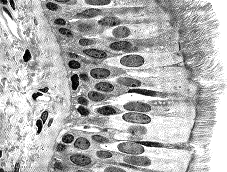The type of tissue illustrated in Figure 39-1 is:

a. elastic connective tissue.
b. simple squamous epithelium.
c. pseudostratified epithelium.
d. cartilage.
e. adipose tissue.
C
You might also like to view...
Often connected to a petiole, these plant organs may be either simple or compound and are typically
the main organs of photosynthesis and gas exchange.
a. roots b. leaves c. flowers d. stems e. trichomes
When blood glucose is low, alpha cells secrete __________, which calls for glycogen breakdown and
glucose release by the liver. Fill in the blank(s) with the appropriate word(s).
Phenotypic sex is determined at the moment of fertilization
a. True b. False
In your fertility clinic, you look at the lab results of a young man. He has a prostate gland the size of a golf ball, a fructose-rich semen, and 10 million sperm per ml. His sperm consist of little more than DNA, mitochondria, and a flagellum, with almost no cytoplasm. Also, he has follicle-stimulating hormone (FSH) and luteinizing hormone (LH) in his bloodstream. Which of these is the likely cause of his fertility problems?
A. FSH and LH B. Enlarged prostate gland C. Fructose in the semen D. Sperm morphology E. Sperm count